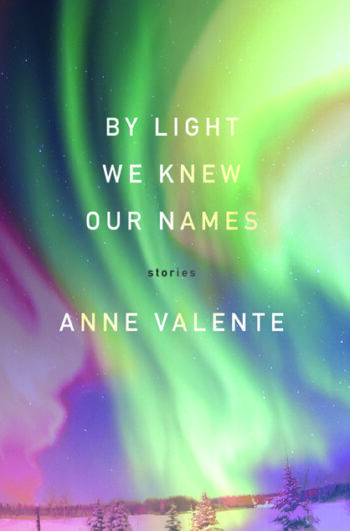
Anne Valente’s stories possess an intimate magic. By Light We Knew Our Names, Valente’s debut collection, enacts the (often terrible) wonder of growing up. In the first two stories, the magic is literal. In “Latchkey,” a girl, Sasha, refuses to open a present she receives for her seventh birthday. Instead she carries the wrapped gift with her everywhere. We soon discover that three of Sasha’s companions possess a touch of enchantment: tiny planets orbit the head of one; another’s belly turns into a fishbowl; another houses a miniscule, talking librarian in her pocket. Sasha longs for “some small mystery to call her own.” What she wants, more than anything, is her own secret to keep.
In “Dear Amelia,” a group of adolescent girls can feel themselves turning into Maine black bears, a secret they cling to along with their undying hope for the success of Amelia Earhart, who is in flight during the time this story is set and to whom the story is addressed. It’s the best story in the collection and it is now one of my all-time favorites. The girls speak in the collective voice: “We learned to shroud our animal truth from the world, and in the end, to obscure our beating hearts. / We hid our hope, Amelia, our bright burning hope that you would succeed.” In By Light We Knew Our Names, the personal is the magical. Many of the stories in this book are about young people coming of age. And while we may not morph into bears or have friends who keep tiny librarians in their pockets, everyone remembers the magic of discovering their own, private selves.
Even stories in which there is no literal magic celebrate the power of imagination. In “To A Place Where We Take Flight,” a pair of middle-school boys gets a gig playing at a hospital where the narrator’s mom is a cancer patient. The narrator holds onto a secret hope that the concert will return his mother’s health. In “Terrible Angels,” a high-school senior who has recently lost her mother sees the angels of her grandparents (mother’s side) everywhere. They leave her mementos—a grappling hook, chalk, a pogo stick—that recall childhood memories and help her find her own footing in the world.
About halfway through the collection, there is a palpable shift. The stories grow up. The characters realize the world’s other mysteries—from global disasters to the frustrating impenetrability of those who they love most. In “Minivan,” a man struggles to connect with his girlfriend in the wake of her rape. In “Not for Ghosts or Daffodils,” a father attempts to understand the eccentric behavior of his young daughter.

Science, not magic, begins to emerge as a common source of wonder in these stories, a contrast to their increasingly harsh worlds. In the title story, four young women start a fight club. They vent their anger for the terrible injustices committed against them in their small Alaskan town: a father who steals his daughter’s paychecks; generations of emotional and physical abuse from boyfriends, family, and men they barely know. This all takes place under the northern lights, which the narrator explains in scientific terms: “The auroras burned bright, shimmering lines, a beauty I knew blazed only from trapped particles, nothing more, ions shuttling toward earth, beating back, enraged that gravity held them.” In “If Everything Fell Silent, Even Sirens,” an expectant mother mourns the recent death of her father, who studied echolocation in dolphins. The story is full of life’s bitterness—the narrator’s anger at her husband, her grief over her father’s death—but it’s also infused with passages that celebrate the miracles of science. In the collection’s closing story, a man is horrified by his boss’s plan to illegally use one hundred baby octopuses as test subjects to uncover the secret behind love. As he cares for the octopuses, he contemplates the mysterious love of his wife, an affection he can never fully understand.
The penultimate story in the collection, “Until Our Shadows Claim Us,” combines the theme of secrets with the reality of disasters beyond our control. The story is told in the collective voice of a class of elementary school kids who believe that their conjuring the phantom of a local killer has led to the kidnappings of their classmates and the coinciding large-scale disasters they see on the news—beginning with The Challenger explosion. They hold their secret close as the kidnappings continue and global disasters unfurl. At the height of their terror, the class proclaims: “We feared the shape of our own organs, that our lungs could fail us, that our hearts could sputter and cease, and that we held things beating inside of us, things we’d never fully understand, things we couldn’t trust.”
Valente’s prose is beautiful. Her verbs are exact and unexpected. Children describe their feet as “tattle-taling our path through the snow behind us.” They tell us their parents “sandboxed our play to the corners of the yard.” A boy’s voice “sliced the stillness in the room.” Her similes are spot-on. Valente turns out stunning sentences like: “I studied the lines of wood in our kitchen table, swirls as complicated as fingerprints.” And: “The baby punches the air behind her, his tiny fists like clementines.” Children recount “the threats pressed like palm prints against our panes.”
There are many authors who use magic in their stories to examine the characters’ personal lives; among them are Aimee Bender, Karen Russell, Ramona Ausubel, and Kelly Luce. There are also many writers, such as Laura van den Berg and Abby Geni, whose stories examine the complexity of human relationships alongside the wonder of nature. But I think it’s best, for the purposes of this review, not to compare Anne Valente to any of them at length. What her debut collection mimics most precisely, for me, is the process of growing up: first, the discovery of the private, impenetrable nature of the self and, second, the inexplicable, often terrible, nature of the world.
All of the stories in this luminous debut straddle the line between the known and the unknowable. By Light We Knew Our Names illustrates the fact that, whether it’s the discovery of your own identity or the inexplicability of others, the world is full of secrets, and we feel most alive when we are trying (futilely) to uncover them. It’s this sense of mystery that torments and sustains us. Valente writes of the girl in the opening story: “But when she looks down at the package, at its paisley edges and purple string, she wonders if what lies beneath could possibly be better than those colors, that pattern, if what’s known is ever better than what isn’t.” This is the question that the collection asks, over and over. It never answers it. But then again, how could it?




